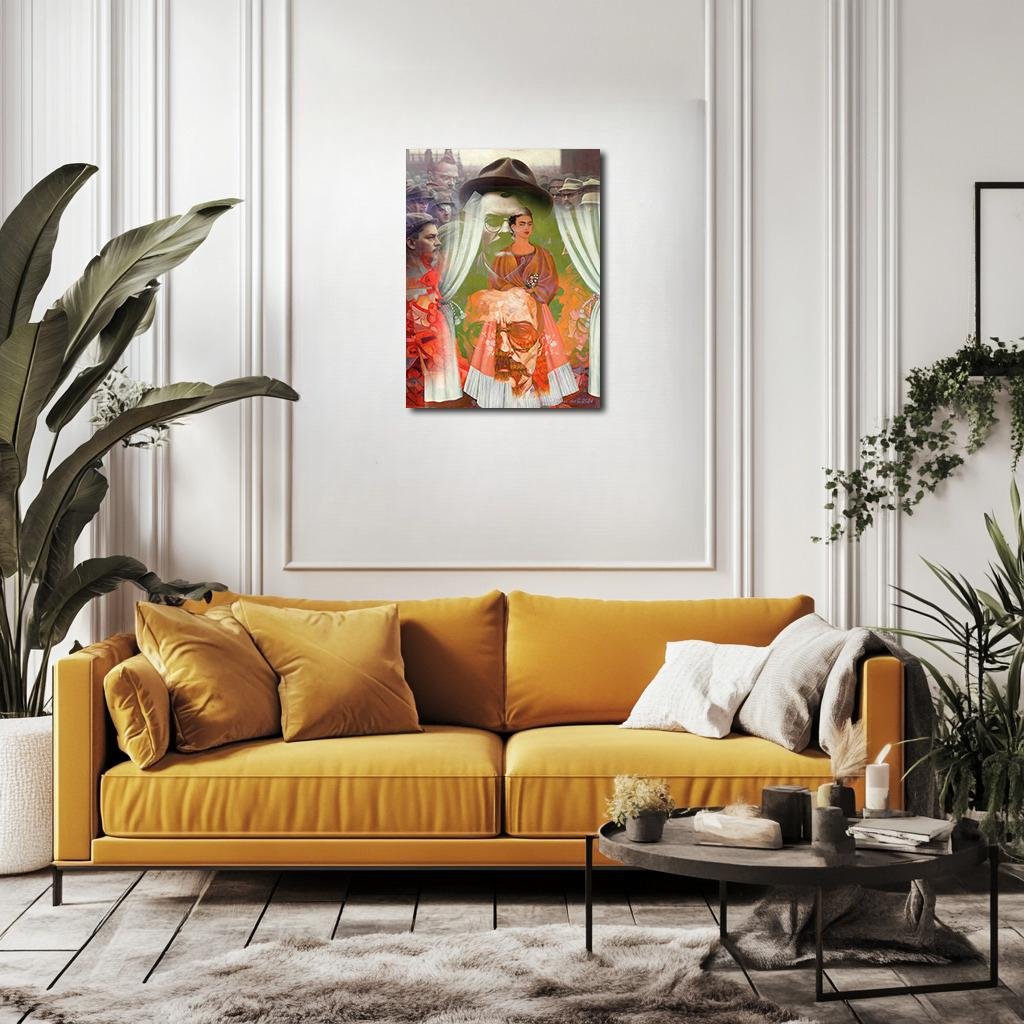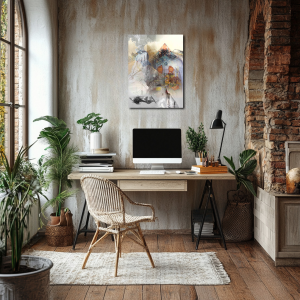Curtains of Memory: Frida’s Farewell to Trotsky
Curtains of Memory reimagines Frida Kahlo’s Self-Portrait Dedicated to Leon Trotsky as a staged farewell where love, ideology, and memory dissolve into layered veils of time. Through vivid crimson, muted sepia, fading ivory, and pale green, Kahlo’s poised figure offers not only flowers, but a testament to fleeting passion and enduring spirit. In this quiet theater of devotion and disillusionment, the piece honors Frida as both participant and witness to the slow, inevitable transformation of history into dream.
Please see Below for Details…
Hotline Order:
Mon - Fri: 07AM - 06PM
404-872-4663
This conceptual reimagining of Frida Kahlo’s Self-Portrait Dedicated to Leon Trotsky extends her complex homage into a layered dreamscape where admiration, ideological passion, and personal distance entangle behind veils of shifting memory. Titled Curtains of Memory , the piece transforms Kahlo’s portrait of offering into a staged theater of affection and separation, where politics and emotion are staged in parallel performances, forever out of complete reach.
At the center of the composition, Frida stands wrapped in a flowing shawl of warm crimson, clutching a bouquet of white and pink flowers close to her chest. Her expression is poised yet remote, capturing the delicate boundary between personal feeling and public gesture. Around her, soft white curtains part to reveal her as if stepping onto a stage, or being framed for a ceremonial moment that has already passed into history.
Behind this scene rises the larger, looming visage of Leon Trotsky, his glasses and mustache rendered with a hazy gravity that suggests both intimacy and distance. His figure is fractured and doubled, blending into a crowd of similarly dressed, solemn-faced men—a blurred army of revolutionaries and followers who fade into muted mist. Their faces multiply and recede, evoking the instability of political dreams once fervent, now slipping into shadow.
The color palette of Curtains of Memory weaves together vibrant life and ghosted nostalgia. Frida’s figure radiates with rich, confident colors: deep cherry reds, clay pinks, and warm sienna earths. Her skin glows with a tender sunlit tone, emphasizing the living presence she offers amidst the fading ideologies around her.
The curtains themselves gleam in soft, faded whites and ivory, suggesting not purity but a quiet sorrow—the faded textiles of abandoned hopes and half-forgotten promises. They part gently, not with triumph but with an almost reluctant grace, making way for a scene that feels simultaneously ceremonial and private.
The figures of Trotsky and his followers are painted in subdued sepias, grayed blues, and rusted brick reds, their colors heavy with the weight of time and disillusionment. Their repetition and fading outlines create a sense of dissolution—men once sharply defined now merging into the anonymous currents of history. Against the lush solidity of Frida’s presence, they feel already consigned to the past.
In the background, a pale, grassy green glows faintly, muted by an overcast sky. This green acts as a fragile hope—echoing the fertile ideals that once fueled revolutions—but it is dulled, veiled by the slow erosion of certainty and the passage of years. It offers light, but not vibrancy; potential, but not fulfillment.
When I created Curtains of Memory , I wanted to explore the emotional architecture behind Kahlo’s act of dedicating her portrait to Trotsky. Her original painting was filled with conflicting tensions: respect, distance, nostalgia for what might have been, an acknowledgment of shared revolutionary passion tempered by personal autonomy. Kahlo admired Trotsky, but she never surrendered her individuality to his cause. In this reimagining, I wanted to stage this layered goodbye—not to the man himself, but to the ideals, dreams, and fleeting intimacies that their connection once symbolized.
The compositional rhythm unfolds downward: the eye is drawn first to the clear, unwavering presence of Frida, then to the heavy, dissolving layers of Trotsky and the crowd behind her. The curtains frame this descent, emphasizing the passage of the viewer from present to past, from clarity to haze. They fall like silent veils over the scene, suggesting that history, no matter how brightly lived, eventually falls into the soft obscurity of recollection.
In this vision, Frida Kahlo is not merely offering flowers; she is offering remembrance—an acknowledgment that all revolutions, all loves, all fervent dreams, must eventually become part of a larger, unfinished story. She does not weep, nor does she celebrate. She stands simply as witness and participant, her body bridging the living warmth of the present and the cooling shadows of memory.
Add your review
Your email address will not be published. Required fields are marked *
Please login to write review!
Looks like there are no reviews yet.








